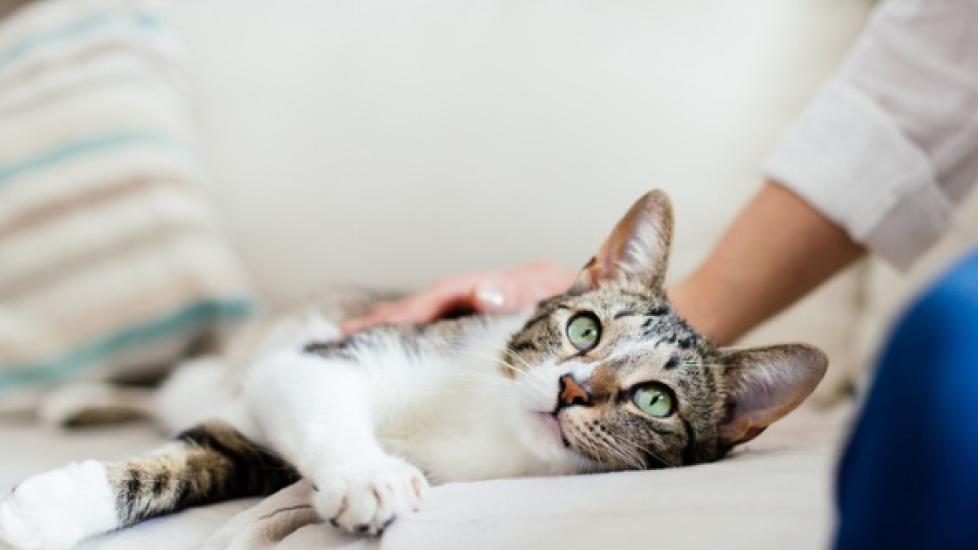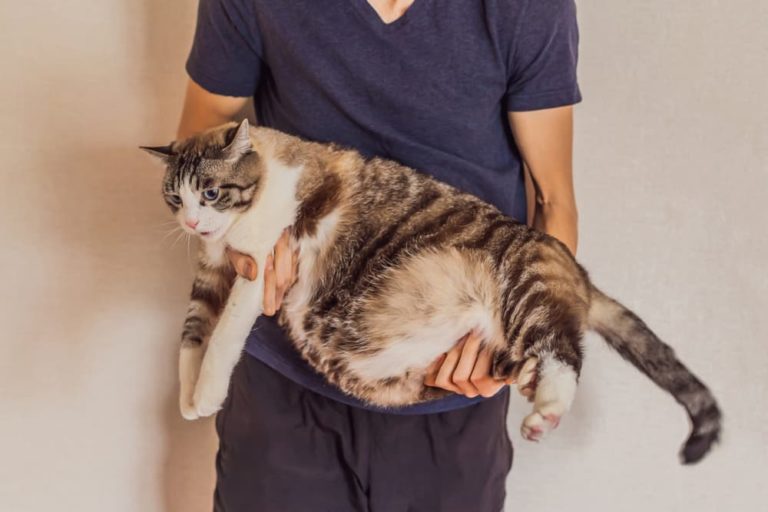Here are eight ways to help your cat lose weight: monitor their food intake, provide portion-controlled meals, incorporate interactive toys for exercise, establish a regular feeding schedule, limit treats and table scraps, encourage playtime, consult with a veterinarian, and consider switching to a weight management cat food. If your feline friend has put on some extra pounds, addressing the issue for their health and well-being is essential.
Obesity in cats can lead to a variety of health problems, including diabetes, arthritis, and heart disease. Luckily, there are several strategies you can implement to help your cat shed those extra pounds and reach a healthier weight. By following these tips, you can support your cat in achieving a more active and balanced lifestyle.

Understanding Feline Obesity
Understanding feline obesity is crucial for cat owners concerned about their pet’s health and well-being. Obesity is a growing problem among cats, with studies showing that about 60% of cats in the United States are overweight or obese. This excess weight can lead to many health issues and reduce your cat’s overall quality of life.
What Is Feline Obesity?
Feline obesity is when a cat’s body weight exceeds its ideal or healthy weight range. It occurs when a cat consumes more calories than it burns off through physical activity. Just like in humans, obesity in cats is primarily caused by a combination of overeating and a lack of exercise.
Causes Of Feline Obesity
Several factors can contribute to feline obesity. One of the leading causes is overfeeding. Many cat owners leave food out all day or provide more significant portions than necessary, leading to weight gain over time. Additionally, feeding cats a diet high in carbohydrates and low in protein can also contribute to obesity, as cats have a natural need for protein-rich food.
Lack of physical activity is another major cause of feline obesity. Cats are naturally agile animals and require regular exercise to maintain a healthy weight. Unfortunately, many indoor cats have limited opportunities for physical activity, leading to weight gain and a sedentary lifestyle.
Health Risks Associated With Feline Obesity
Feline obesity can have serious health consequences for your cat. The extra weight strains their joints and bones, increasing the risk of arthritis and other musculoskeletal conditions. Obesity also puts cats at a higher risk of developing diabetes, heart disease, and respiratory problems.
Furthermore, obesity can affect a cat’s overall well-being and quality of life. Overweight cats may become lethargic and have less energy for physical activity and play. They may also experience discomfort and difficulty grooming themselves, leading to skin and coat problems.
Cat owners need to recognize the signs of obesity and take steps to help their cats maintain a healthy weight. By understanding the causes of feline obesity and its risks, you can make informed decisions about your cat’s diet and exercise routine to ensure their long-term health and happiness.
:strip_icc()/veterinarian-examining-cat-in-vet-s-surgery-164853873-5a6e2293c064710037c9c2f8.jpg)
Creating A Weight Loss Plan
Is your furry feline in need of shedding a few pounds? Discover eight practical ways to help your cat lose weight and maintain a healthy lifestyle. These strategies, from portion control to active play, can transform your cat’s well-being.
Consulting With A Veterinarian
Before starting a weight-loss plan for your cat, it’s crucial to consult with a veterinarian. Your vet will assess your cat’s current health condition, including any underlying medical issues that may contribute to weight gain. They will also guide you on how much weight your cat needs to lose and the ideal timeline for achieving this goal. Your vet’s expertise is essential in creating a safe and effective weight loss plan tailored to your cat’s needs.
Setting Realistic weight-loss Loss Goals
Setting realistic goals is essential to ensuring your cat’s weight-loss journey is successful. Your veterinarian will help determine the ideal weight range for your cat based on factors such as breed, age, and overall health. Aim for gradual weight loss, typically around 1-2% of their weekly body weight. Remember that slow and steady progress is better than rapid weight loss, as it allows for a more sustainable lifestyle change.
Designing A Balanced Diet Plan
A well-designed diet plan is crucial for your cat’s weight-loss success. Ensure their meals are nutritionally balanced, providing essential nutrients while keeping calorie intake in check. Look for high-quality, lower-calorie cat food options explicitly formulated for weight management. Consider portion control and divide their meals into small, frequent daily feedings to prevent overeating. Remember that sudden dietary changes can be challenging for your cat, so transitioning gradually may help them adjust more quickly.
Incorporating Exercise Into Your Cat’s Routine
Exercise plays a vital role in helping your cat shed those extra pounds. Provide opportunities for physical activity by incorporating playtime into their daily routine. Engage them in interactive games that encourage movements like chasing a laser pointer or batting at toys. Set aside dedicated play sessions each day and make them fun and stimulating. Gradually increase the duration and intensity of exercise to help your cat build stamina and burn more calories.
To make it more interactive and user-friendly, let’s summarize the key points in a table:
| H3 Headings | Key Points |
|---|---|
| Consulting with a veterinarian | Your vet will assess your cat’s health, identify underlying medical issues, and create a personalized weight loss plan. |
| Setting realistic weight-loss goals | Set achievable weight loss goals, aiming for gradual progress of 1-2% body weight per week. |
| Designing a balanced diet plan | Choose nutritionally balanced, lower-calorie cat food options and practice portion control. |
| Incorporating exercise into your cat’s routine | Engage your cat in interactive play sessions and gradually increase exercise duration and intensity. |
Implementing these strategies will significantly contribute to your cat’s weight-loss journey. Remember to regularly monitor their progress, make adjustments as needed, and provide them with the love and support they need. With a well-designed weight loss plan, your cat will be on their way to achieving a healthier and happier life.
Implementing Healthy Habits
Discover eight practical ways to help your cat shed those extra pounds and maintain a healthy weight. These helpful tips will ensure your feline friend is on the right path to a happy and active life.
Implementing healthy habits is crucial in helping your cat lose weight. By making a few changes to their routine, you can encourage a healthier lifestyle that will contribute to gradual weight loss. This article will discuss eight practical ways to help your cat shed those extra pounds. Let’s start by looking at the first step: controlling portion sizes.
Controlling Portion Sizes
Controlling the food your cat consumes is paramount to managing their weight. Overfeeding can lead to excessive weight gain, so it’s essential to establish proper portion control. Consider the following strategies:
- Consult your veterinarian to determine the appropriate daily calorie intake for your cat’s age, weight, and size.
- Measure your cat’s meals using a scale or measuring cup to ensure accuracy.
- Avoid using large bowls for feeding, as it can make it challenging to gauge portion sizes.
- Divide their daily food allowance into several smaller meals throughout the day.
Avoiding Free-feeding
Free-feeding, where food is available to your cat all day, can result in overeating. Instead, establish set meal times and avoid leaving food out constantly. Some tips to help you transition from free-feeding to scheduled meals include:
- Remove any leftover food between meals to prevent grazing.
- Gradually decrease the time food is available to your cat until they get used to scheduled meal times.
- Provide plenty of fresh water at all times to keep your cat hydrated.
Choosing Nutritious Cat Food
Feeding your cat a high-quality, nutritionally balanced diet is essential for their health and weight management. Consider the following when selecting cat food:
- Look for cat food labelled “complete and balanced” to ensure it meets all their nutritional needs.
- Check the ingredient list for high-quality protein sources and limited amounts of fillers or carbohydrates.
- Consider consulting with your veterinarian for recommendations on specific weight-management cat food options.
Introducing Interactive Toys And Games
Increasing your cat’s physical activity can help burn calories and promote weight loss. Interactive toys and games can keep your cat engaged and help them shed those extra pounds. Here’s how you can make playtime more stimulating:
- Provide toys encouraging your cat to move and chase, such as feather wands or interactive puzzle toys.
- Rotate toys frequently to keep your cat’s interest and prevent boredom.
- Set aside dedicated playtime every day to ensure your cat gets regular exercise.
Creating A Feeding Schedule
Establishing a consistent feeding schedule for your cat can help regulate their appetite and prevent overeating. Consider the following steps to create a feeding schedule:
- Divide your cat’s daily food allowance into the recommended number of meals.
- Select specific meal times that work best for your and your cat’s routine.
- Stick to the schedule and avoid giving extra treats or snacks throughout the day.
- Monitor your cat’s weight and adjust the portion sizes accordingly if necessary.

Frequently Asked Questions For 8 Ways To Help Your Cat Lose Weight
How Can I Help My Overweight Cat Lose Weight?
To help your overweight cat lose weight, you can start by feeding them a balanced diet of low-calorie cat food. Please encourage them to be more active by engaging them in playtime or using puzzle toys. Gradually increase their exercise and monitor their weight regularly to track progress.
Is It Safe To Put My Cat On A Weight Loss Diet?
Yes, it is safe to put your cat on a weight-loss diet, but it should be done under the guidance of a veterinarian. Rapid weight loss can harm cats, so a gradual and controlled approach is recommended.
Consult a professional to meet your cat’s nutritional needs while losing weight.
How Much Exercise Does My Cat Need To Lose Weight?
Ideally, cats should engage in at least 30 minutes of exercise per day to lose weight. This can include interactive play sessions, using toys that encourage movement, or providing climbing structures for them to explore. Start slow and gradually increase exercise time to avoid overwhelming your cat.
Can I Use Treats As A Snack While My Cat Is On A Weight Loss Program?
Limiting or avoiding treats while your cat is on a weight loss program is best. Many commercial cat treats are high in calories and can hinder weight loss progress. If you offer treats, choose low-calorie options and factor them into your cat’s daily calorie intake.
Moderation is key.
Conclusion
Incorporating these eight strategies into your cat’s daily routine can significantly contribute to their weight loss journey. Remember to consult with your veterinarian to ensure the safety and effectiveness of these methods. By providing a balanced diet, engaging in regular exercise, and monitoring their progress, you can help your cat achieve a healthy weight.
So, start implementing these tips today and enjoy witnessing your furry friend’s improved health and vitality.

